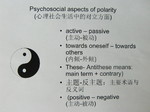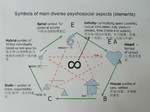International Congress of TCM Psychology and sleep medicine - May 2011, Bejing
Old Chinese systems for Psychology from a western point of view
Two lectures by F. Badelt at the International Congress of TCM Psychology and Sleep medicine in Bejing in May 2011 under the leaderships of Prof. Wang Weidong:
Congress Shen - Interculturality and Psychotherapy
Congress from June 10th - 14th 2010 plus June 17th (post colloquium)
Leadership: Prof. Friedrich Wallner (University of Vienna, department of philosophy),
Prof. Lan Fengli (University of TCM, Shanghai)
Place: Sigmund Freud University, Vienna (Rektor A. Pritz)
Meeting between East and West : June 14th, 2010, Introduction by F. Badelt:
"Human evolution based upon old chinese pattern?"
More information under www.ipcm-vienna.at
East meets west: "Human evolution based upon old Chinese patterns?"
Different psychosocial shen aspects from a western point of view
Polar thinking and the 5 phase’s rotation system – both concepts taken from acupuncture theory – can be interpreted as cognitive methods approaching different aspects of shen spirit. If applied to psychology a combination of these two systems can be regarded as a comprehensive healing model.
Like the 5 Old Chinese elements in nature (fire, earth, metal, water, wood), 5 different ideas or shen aspects (contact, care, order and responsibility, awareness of own limitation and destination, self-realization) further and limit each other clockwise. According to the authors opinion the whole circuit and balance among the diversity is additionally influenced by our vivid atmosphere: by our own personal life joy or lust (working from inside) and our personal (social and cultural) environment – both in correspondence with the sixth pair of main meridians (named in German language, referring to J. Bischko: Kreislauf, Sex – dreifacher Erwärmer) and in correspondence with the missing element “air” in TCM.
In each field components with the polar aspects: Thesis – Antithesis; active – passive; towards oneself – towards others are to be considered and put into balance as good as possible according to the principle of Tai Chi. Personal feelings of balance concerning own thinking, own behavior and own emotions in as many as possible aspects build a good healing atmosphere for our body, our mind and our social lifestyle.
On the other hand misbalance, deficiencies, severe fluctuations of polar functions often go along with daily stress, psychosomatic risks or mental illnesses. One sided life joy, contra clockwise phases rotation, short-cuts with lack of single elementary fields, signs of suppression or disregard caused by dominating functions describe further risks of an unhealthy lifestyle, which can end up in psychopathology whereas the description of natural clockwise phases rotation and diagonal clockwise limitation offers individual healing strategies. For better illustration typical cognitions, behavior and emotions of every day´s life are listed up and comparisons between healthy and unhealthy dynamics are presented by use of western terms.
Placing bipolar groups of different thoughts, behavior and emotions into the old Chinese Phases rotation system allows a combination of two ways of thinking – Western analytic and Chinese synthetic.
Thus an intercultural approach regarding various shen aspects is of benefit for both sides.
Cooperation of polar aspects (yin-yang aspects) in our thinking, feeling and behavior can be experienced balanced or more or less disturbed (both parts deficient, being out of balance or extremly shifting, sometimes also in conflict) - thus causing different sources of stress.
Read more about it under :
Yin - Yang for Psychology with examples from every day life and Evaluation of polarity in lifestyle
More information about how to apply the old chinese phases rotation system to psychology in order to get hints for possible psychosocial evolution (or to describe its failure) you can find under: wu-xing for psychology , where some examples of natural and dysfunctional patterns are listed up.
More (in german language) you can find in my book: Psychosomatische Vorsorgemedizin








